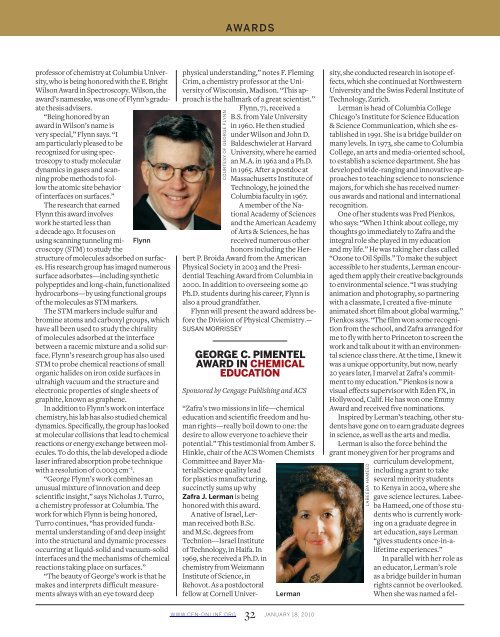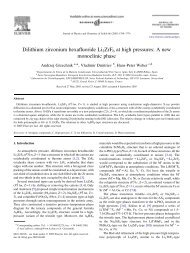Chemical & Engineering News Digital Edition - January 18, 2010
Chemical & Engineering News Digital Edition - January 18, 2010
Chemical & Engineering News Digital Edition - January 18, 2010
Create successful ePaper yourself
Turn your PDF publications into a flip-book with our unique Google optimized e-Paper software.
professor of chemistry at Columbia University,<br />
who is being honored with the E. Bright<br />
Wilson Award in Spectroscopy. Wilson, the<br />
award’s namesake, was one of Flynn’s graduate<br />
thesis advisers.<br />
“Being honored by an<br />
award in Wilson’s name is<br />
very special,” Flynn says. “I<br />
am particularly pleased to be<br />
recognized for using spectroscopy<br />
to study molecular<br />
dynamics in gases and scanning<br />
probe methods to follow<br />
the atomic site behavior<br />
of interfaces on surfaces.”<br />
The research that earned<br />
Flynn this award involves<br />
work he started less than<br />
a decade ago. It focuses on<br />
using scanning tunneling microscopy<br />
(STM) to study the<br />
Flynn<br />
structure of molecules adsorbed on surfaces.<br />
His research group has imaged numerous<br />
surface adsorbates—including synthetic<br />
polypeptides and long-chain, functionalized<br />
hydrocarbons—by using functional groups<br />
of the molecules as STM markers.<br />
The STM markers include sulfur and<br />
bromine atoms and carboxyl groups, which<br />
have all been used to study the chirality<br />
of molecules adsorbed at the interface<br />
between a racemic mixture and a solid surface.<br />
Flynn’s research group has also used<br />
STM to probe chemical reactions of small<br />
organic halides on iron oxide surfaces in<br />
ultrahigh vacuum and the structure and<br />
electronic properties of single sheets of<br />
graphite, known as graphene.<br />
In addition to Flynn’s work on interface<br />
chemistry, his lab has also studied chemical<br />
dynamics. Specifically, the group has looked<br />
at molecular collisions that lead to chemical<br />
reactions or energy exchange between molecules.<br />
To do this, the lab developed a diode<br />
laser infrared absorption probe technique<br />
with a resolution of 0.0003 cm –1 .<br />
“George Flynn’s work combines an<br />
unusual mixture of innovation and deep<br />
scientific insight,” says Nicholas J. Turro,<br />
a chemistry professor at Columbia. The<br />
work for which Flynn is being honored,<br />
Turro continues, “has provided fundamental<br />
understanding of and deep insight<br />
into the structural and dynamic processes<br />
occurring at liquid-solid and vacuum-solid<br />
interfaces and the mechanisms of chemical<br />
reactions taking place on surfaces.”<br />
“The beauty of George’s work is that he<br />
makes and interprets difficult measurements<br />
always with an eye toward deep<br />
AWARDS<br />
physical understanding,” notes F. Fleming<br />
Crim, a chemistry professor at the University<br />
of Wisconsin, Madison. “This approach<br />
is the hallmark of a great scientist.”<br />
Flynn, 71, received a<br />
B.S. from Yale University<br />
in 1960. He then studied<br />
under Wilson and John D.<br />
Baldeschwieler at Harvard<br />
University, where he earned<br />
an M.A. in 1962 and a Ph.D.<br />
in 1965. After a postdoc at<br />
Massachusetts Institute of<br />
Technology, he joined the<br />
Columbia faculty in 1967.<br />
A member of the National<br />
Academy of Sciences<br />
and the American Academy<br />
of Arts & Sciences, he has<br />
received numerous other<br />
honors including the Herbert<br />
P. Broida Award from the American<br />
Physical Society in 2003 and the Presidential<br />
Teaching Award from Columbia in<br />
2000. In addition to overseeing some 40<br />
Ph.D. students during his career, Flynn is<br />
also a proud grandfather.<br />
Flynn will present the award address before<br />
the Division of Physical Chemistry.—<br />
SUSAN MORRISSEY<br />
COURTESY OF GEORGE FLYNN<br />
GEORGE C. PIMENTEL<br />
AWARD IN CHEMICAL<br />
EDUCATION<br />
Sponsored by Cengage Publishing and ACS<br />
“Zafra’s two missions in life—chemical<br />
education and scientific freedom and human<br />
rights—really boil down to one: the<br />
desire to allow everyone to achieve their<br />
potential.” This testimonial from Amber S.<br />
Hinkle, chair of the ACS Women Chemists<br />
Committee and Bayer MaterialScience<br />
quality lead<br />
for plastics manufacturing,<br />
succinctly sums up why<br />
Zafra J. Lerman is being<br />
honored with this award.<br />
A native of Israel, Lerman<br />
received both B.Sc.<br />
and M.Sc. degrees from<br />
Technion—Israel Institute<br />
of Technology, in Haifa. In<br />
1969, she received a Ph.D. in<br />
chemistry from Weizmann<br />
Institute of Science, in<br />
Rehovot. As a postdoctoral<br />
fellow at Cornell Univer- Lerman<br />
WWW.CEN-ONLINE.ORG 32 JANUARY <strong>18</strong>, <strong>2010</strong><br />
sity, she conducted research in isotope effects,<br />
which she continued at Northwestern<br />
University and the Swiss Federal Institute of<br />
Technology, Zurich.<br />
Lerman is head of Columbia College<br />
Chicago’s Institute for Science Education<br />
& Science Communication, which she established<br />
in 1991. She is a bridge builder on<br />
many levels. In 1973, she came to Columbia<br />
College, an arts and media-oriented school,<br />
to establish a science department. She has<br />
developed wide-ranging and innovative approaches<br />
to teaching science to nonscience<br />
majors, for which she has received numerous<br />
awards and national and international<br />
recognition.<br />
One of her students was Fred Pienkos,<br />
who says: “When I think about college, my<br />
thoughts go immediately to Zafra and the<br />
integral role she played in my education<br />
and my life.” He was taking her class called<br />
“Ozone to Oil Spills.” To make the subject<br />
accessible to her students, Lerman encouraged<br />
them apply their creative backgrounds<br />
to environmental science. “I was studying<br />
animation and photography, so partnering<br />
with a classmate, I created a five-minute<br />
animated short film about global warming,”<br />
Pienkos says. “The film won some recognition<br />
from the school, and Zafra arranged for<br />
me to fly with her to Princeton to screen the<br />
work and talk about it with an environmental<br />
science class there. At the time, I knew it<br />
was a unique opportunity, but now, nearly<br />
20 years later, I marvel at Zafra’s commitment<br />
to my education.” Pienkos is now a<br />
visual effects supervisor with Eden FX, in<br />
Hollywood, Calif. He has won one Emmy<br />
Award and received five nominations.<br />
Inspired by Lerman’s teaching, other students<br />
have gone on to earn graduate degrees<br />
in science, as well as the arts and media.<br />
Lerman is also the force behind the<br />
grant money given for her programs and<br />
curriculum development,<br />
including a grant to take<br />
several minority students<br />
to Ken ya in 2002, where she<br />
gave science lectures. Labeeba<br />
Hameed, one of those students<br />
who is currently working<br />
on a graduate degree in<br />
art education, says Lerman<br />
“gives students once-in-alifetime<br />
experiences.”<br />
In parallel with her role as<br />
an educator, Lerman’s role<br />
as a bridge builder in human<br />
rights cannot be overlooked.<br />
When she was named a fel-<br />
LABEEBA HAMEED




